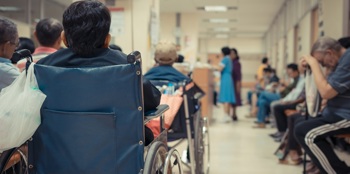
What are virtual wards?
So, what is a virtual ward? A virtual ward is a way of monitoring care provided away from a hospital ward. A patient is discharged to a virtual ward meaning they are still receiving regular checks and interactions with doctors and nurses, but without the noise and bustle of a busy hospital.
When we query what is a ward, the NHS data dictionary states it is “A group of Hospital Beds with associated treatment facilities managed as a single unit for the purposes of staffing and treatment responsibilities.” Critics may argue that care in your own home is not that of a hospital bed, but aside that the principles are still the same. A virtual ward is a group of beds (albeit the individuals’) with associated treatment and managed as a single unit.
A common virtual ward definition specifies virtual wards as providing community healthcare for those with complex medical needs, but the virtual ward concept goes further than this. Virtual wards are designed to support people with healthcare in a more relaxed setting, with the benefits being reduced stress and improved recovery.
Virtual wards aren't a replacement for hospital care, they are an alternative. They are an option, a choice, for patients who should have a say in their healthcare. They also offer the NHS the chance to be more efficient; providing the best care possible whilst being able to properly prioritise urgent care and ongoing care.
How does a virtual ward work?
Virtual wards are fully supported by nurses and doctors like a regular hospital ward and the NHS is steadily introducing them. This is partly for convenience, at home or within a care home setting, but most importantly for the patient’s sake.
Healthcare professionals still do home visits, but support can also be provided via video calls through a tablet device; allowing clinicians to check-in on patients and respond to urgent calls for assistance should a person become unwell. The patient is also given tech devices to help them self-monitor and remotely report back their own vitals; things such as heart rate, blood pressure, blood oxygen levels, and overall movement.
NHS virtual wards will still be treated in the same manner as wards in hospital, but the trade offs are the increased flexibility with patient interaction and inspection, as well as the greater comfort for the patient to recuperate in a more comfortable setting.
The Access Group is supporting both proactive care and reactive responses with two software solutions; Rio EPR Virtual Pathways is the core software for clinician-patient interaction, and it is underpinned by Access Assure and its remote monitoring tools.

What is a virtual hospital bed?
Virtual hospital beds are beds allocated to patients on the virtual ward. These virtual beds are located outside of the hospital ward setting and can either be the patient's own bed at home or a bed in a community care setting.
Patient management systems can monitor the availability of virtual hospital beds. For a patient's own home this isn't typically an issue, but assisted care and other forms of community care may have limitations on free spaces. It is important to be aware of these limitations on virtual beds before moving people into virtual wards as the care may be inappropriate and even detrimental should the virtual hospital bed not be available for recovery.
Virtual wards NHS
One of the big search terms related to this subject matter is ‘what is a virtual ward NHS’, and it’s a difficult question to answer on behalf of the NHS because of the operational structure. Beyond our earlier definition of a virtual ward, each NHS trust or regional body has its own approach to what a virtual ward is treating and how they are allocating resources to it.
NHS virtual wards are already being trialled across the UK with many NHS trusts, with the initial focus on support for frail patients and those with acute respiratory infections – whether Covid related or not. This started in response to the pandemic and the incredible surge in demand for urgent care but the cyclical nature of attending hospital with an illness inevitably risks spreading it to others, and vice versa. By supporting people in a home setting, the NHS can better isolate the spread of coughs, colds, and Covid-19.
Self-management of care deteriorates the longer the stay on wards in hospital, meaning it's much more difficult to maintain independence when on a ward and after discharge. Then there is also personal preference. Not many people want to be admitted to hospital, rather they go out of necessity, but if they had a choice most would prefer to remain in their own surroundings. It’s more familiar, more comfortable, and they have more control over their environment. This is especially beneficial when considering those who don’t deal well with change.
It’s important to remember that this is just a glimpse of the future for the NHS. Dedicated healthcare professionals still give face-to-face care with patients, and this is unlikely to ever change. The social interaction between clinician and patient is important and can often give insights that data alone cannot. The introduction of virtual wards across the UK could reduce the care burden though. This would allow for more preventative action and allow community care to provide beds. This means less demand on hospital wards and a greater capacity to accommodate new admissions.
These NHS trials are issuing virtual ward patients with a home care package. The remote monitoring can track the following:
- Heart rate
- Blood pressure
- Blood oxygen saturation
- Skin temperature
- General movement
The virtual ward might be a more relaxed setting, but it is designed to respond as a hospital ward would. Nurses check in daily via the tablet through a video call, but patients do have a very obvious “I’m not feeling very well” button to press on the tablet’s home screen should they take ill.
Data is communicated via the tablet and modem every three minutes. The kit is designed so that it does not require a patient to have their own internet service, and nursing staff will monitor the person’s vitals in case they see any signs for concern before a patient does.

Benefits of virtual wards
There are four key benefits to having NHS virtual wards:
- To reduce congestion within a hospital/care setting
- They are cost-effective
- They free up secondary care beds for critical/urgent patients
- They complement the existing work of healthcare professionals
Demand for healthcare provision is continuing to grow as healthcare technology and medicine both extend the average person’s lifespan. People are living longer and therefore experiencing more instances of illness or injury. This added care demand means more people on wards in hospital – even temporarily – which is why the virtual hospital ward can be so impactful in helping. The British Medical Journal (amongst others) has written about the loss of life caused by the increase in demand and the issues with either accommodating patients or giving them an adequate amount of care provision.
There is also the issue of less severe problems taking up bed space that could be reallocated to urgent or critical patients. The hospital setting is always described as being busy, noisy, and having not very nice food. People regularly give feedback about feeling overwhelmed by the hubbub of people, the constant sound of machine bleeps, and the general congestion of a hospital. It is a win-win for patients to be put on a virtual ward pathway and assisted in their recovery from a home setting, whilst enabling the hospital to accommodate all those in need. People aren’t stressed and people aren’t left waiting for help.
The National Institute for Health and Care Excellence (NICE) performed a series of investigations in 2017 to assess the potential benefits of virtual wards. Aside NICE guidelines for virtual wards, Section 12.4 of their report breaks down the savings per patient in each study performed, with costs reduced in one study by £9,081 per patient. Reports from the British Journal of Healthcare Management and NHSX cite the following statistics as the benefits of virtual ward care pathways:
- 3% reduction in the average length of hospital stay
- 50% reduction in re-admission rate when using a virtual ward
- £1,047 in estimated savings per patient, per day, when using a virtual ward
- 94% of patients felt more confident about being able to manage their condition
- 5% reduction in unscheduled emergency admissions when using virtual wards
- 484% return on investment for every £1 spend on TEC to remotely monitor patients
The most understated point is how a virtual ward can benefit existing clinical staff. Time is finite and virtual wards can carve out more face-to-face time for doctors and nurses with those patients most in need. Patient A with a broken leg might not need as much attention and as regularly as Patient B who is recovering from pneumonia. Patient software and the tools to self-record information can help healthcare professionals focus their time on priority care cases, leading to better treatment outcomes.

NHSE Virtual Wards Operational Framework
Following the success of the South East region’s virtual wards initiative that saved over £10 million annually, NHS England (NHSE) has announced a rapid expansion of virtual wards across the UK and has published an updated operational framework to support meeting the goals set out in the NHS 2024/25 Urgent and Emergency Care Recovery Plan.
The framework mandates that virtual wards, designed to treat acute conditions at home as an alternative to hospital care, must be led by GPs, consultants, or consultant practitioners and must meet the following requirements:
- Strong governance and clinical leadership, with oversight from a consultant physician, consultant practitioner, or GP.
- Operating hours from 8am to 8pm, seven days a week, with arrangements for out-of-hours support.
- Defined criteria for admission and assessment processes.
- Individualised care planning and collaborative decision-making with patients.
- Daily ‘board’ rounds led by a senior clinician, with involvement and input from the wider multidisciplinary team.
- Access to hospital-grade diagnostics.
- Provision of hospital-equivalent treatments and interventions.
- Use of remote patient monitoring (RPM) and other technologies to assist in care delivery.
- Optimisation and medical reconciliation of pharmacy services.
- Clear processes for discharge with tracking of patient length of stay.
To find out how Access can help you get started and achieve your virtual wards goals, download our Virtual Wards guide.
Setting up a virtual ward
To be effective a virtual ward must have the appropriate support of both staff and technology. Beds have to be managed or procured, care services require purchasing, and patient data has to be monitored.
The Access Group has a six point rundown of how a virtual ward might operate, using Access software tools:
- Patient identified as virtual ward candidate
A patient needs acute care but can be supported in Virtual Ward - Establish care services
This is where clinicians decide between care in your own home or in a care home. - Access Adam Care Commissioning
Tools like Access Adam help to procure home care services or continuing healthcare provision with approved and quality providers. - Access Patient Flow Management
Formerly known as ‘Flow’, Access PFM is informed by Adam of the request to provide a patient with home or residential care. - Access Rio EPR or Access Assure
Depending on the choice, a trust will want to handle patient records or in-home monitoring or both. Access Rio electronic patient records and Access Assure handle each option, but both can communicate to share data and reports and work in sync. - Access Workspace: Data Engine
Access’ Data Engine takes information from both EPR and Assure, allowing for analysis of recorded data and trends that can be extrapolated from the information.
The two main software aides that NHS virtual wards - or any organisation for that matter - would want to take advantage of are Access Patient Flow Management and Access Adam Care Commissioning.
Access’ Patient Flow Management flags information on a Virtual Ward whiteboard. It displays information about a patient’s location, their journey through a hospital and back home or into a care home, and can receive updates and data feeds from relevant devices. It also displays a patient’s needs, risks, things such as allergies, and allows care managers to plan their teams to assign the more relevant professionals to each patient.
Access Adam is important as it supports the initial establishment of a patient in the virtual ward, whether procuring continuing healthcare (CHC) or home care services, it works to connect the requirements of a patient to the most appropriate provider. By integrating with other products across the market, it can help to track a patients care and share this date with the appropriate care providers. For instance, using the data to update Patient Flow Management’s virtual ward with details of where the patient is placed, and provide a comparison link with Rio EPR for record access.
Access products can support the whole virtual ward process – from establishing beds to reporting on progress of patients – and now is the time that healthcare organisations should be looking at establishing the right practices and protocols for virtual wards. As the global population continues to grow, so too will the demand for healthcare. Training takes time, but the pressure of care provision is also intense.
The Access Group support this by aiding the shift from reactive care to proactive care responses. Rio EPR Virtual Pathways is the core software for clinician-patient interaction, and it is underpinned by Access Technology Enabled Care (TEC).
Our latest integration with the Access Assure Home Hub and our care planning software can help facilitate the virtual ward further by allowing carers visibility to the smart alerts and alarms from the Home Hub into the mobile care planning app. This enhances the activity information they can have access to between visits to reduce risks and identify issues before they occur.
By utilising virtual wards and software solutions, healthcare providers could potentially overcome virtual wards challenges, as well as save time and money by allowing software and data to direct their priorities, whilst also benefiting the patient with a more comfortable recovery process away from hospital.

The three main software aides that NHS virtual wards - or any organisation for that matter - would want to take advantage of are Access Patient Flow Management, Access Elemental and Access Adam Care Commissioning.
Access’ Patient Flow Management flags information on a Virtual Ward whiteboard. It displays information about a patient’s location, their journey through a hospital and back home or into a care home, and can receive updates and data feeds from relevant devices. It also displays a patient’s needs, risks, things such as allergies, and allows care managers to plan their teams to assign the more relevant professionals to each patient.
Access Adam is important as it supports the initial establishment of a patient in the virtual ward, whether procuring continuing healthcare (CHC) or home care services, it works to connect the requirements of a patient to the most appropriate provider. By integrating with other products across the market, it can help to track a patients care and share this date with the appropriate care providers. For instance, using the data to update Patient Flow Management’s virtual ward with details of where the patient is placed, and provide a comparison link with Rio EPR for record access.
Social prescribing is handled by Access Elemental. This software connects clinicians and others to social prescribing link workers, who in turn connect to the patient in the community. This is for people who are experiencing things such as chronic pain or mental health problems, where community-based action can be less stressful and more beneficial to care. Elemental handles referrals and reports back to stakeholders such as GPs, charities, and the link worker about the patient’s condition, their experience, and most importantly their needs.

